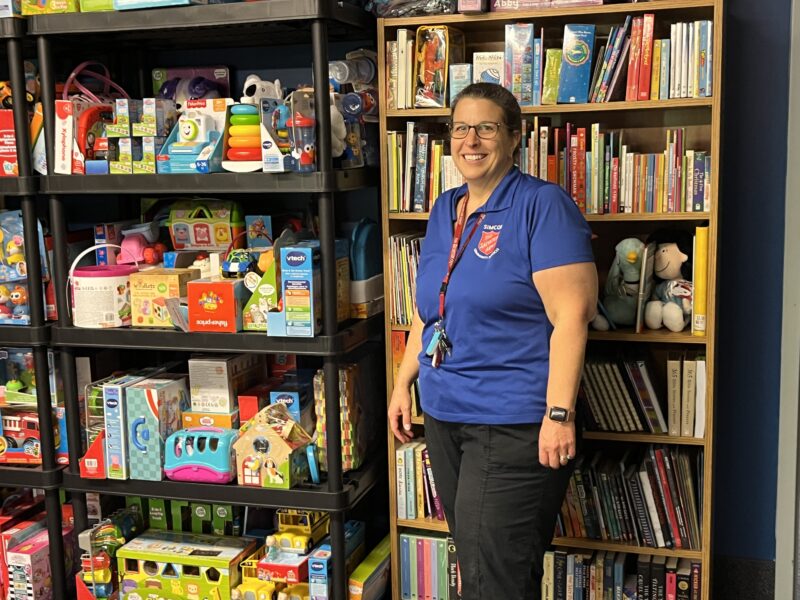Vous ne le savez peut-être pas, mais les banques alimentaires ne se contentent pas de donner de la nourriture à leurs communautés. En plus de la des millions de livres de nourriture fraîche, congelée et non périssable Les banques alimentaires offrent également des services vitaux qui peuvent soutenir le bien-être des gens, fournir des occasions d'acquérir des compétences et apporter un sentiment d'appartenance à ceux qui traversent une période difficile. Bien que tous les programmes ne soient pas offerts par toutes les banques alimentaires, chaque banque alimentaire locale offre des services uniques, adaptés aux besoins de leur région.
Voici 12 façons dont notre réseau aide les gens en leur fournissant bien plus que de la nourriture.
Soutiens fondamentaux

Un tableau d'affichage des emplois dans une banque alimentaire de notre réseau.
De nombreuses banques alimentaires proposent des services visant à atténuer les raisons pour lesquelles une personne se tourne vers une banque alimentaire en premier lieu, en aidant les gens à se remettre sur pied.
1. Services de l'emploi
Si une personne a besoin d'aide pour acquérir des compétences professionnelles, rechercher un emploi, se vêtir pour un entretien ou obtenir des conseils en matière d'emploi, les banques alimentaires ont souvent des programmes qui peuvent l'aider à acquérir de nouvelles compétences.
Le programme de leadership en logistique à Banque alimentaire North York Harvestest un excellent exemple. Ce programme permet d'acquérir une expérience professionnelle dans l'entrepôt de la banque alimentaire grâce à un programme de formation rémunéré qui peut déboucher sur un emploi permanent.
2. Subventions pour le logement et les services publics
Lorsque les revenus d'une personne ne couvrent pas ses dépenses de base, il est souvent très angoissant de s'inquiéter de la possibilité de garder un toit au-dessus de sa tête ou de maintenir le chauffage en hiver.
Des programmes comme Le CHU - un carrefour d'opportunités Le programme Keep the Heat fournit aux familles des fonds pour les aider à payer leur facture d'énergie. Les programmes de ce type permettent d'alléger les dépenses importantes et d'aider les personnes et les familles à se remettre sur pied.
3. Cliniques fiscales
Les obstacles à la déclaration des revenus empêchent souvent les personnes d'accéder aux prestations auxquelles elles pourraient avoir droit, comme la prestation Trillium de l'Ontario.
De nombreuses banques alimentaires organisent des permanences fiscales, comme Banques alimentaires Mississaugadont les permanences fiscales annuelles permettent à chacun de bénéficier d'une aide pour remplir sa déclaration de revenus et accéder à sa déclaration et à ses avantages fiscaux.
Soutenir le bien-être

Un cours de yoga communautaire gratuit se déroule à la banque alimentaire de Cambridge.
La pauvreté et l'insécurité alimentaire peuvent conduire à les défis en matière de santé mentale et un stress accru. Pour aider ceux qui n'ont pas accès à d'autres ressources de soutien, les banques alimentaires de notre réseau offrent des espaces où les visiteurs peuvent bouger leur corps, soulager leur stress et entrer en contact avec d'autres personnes.
4. Cours de yoga et de fitness
Des cours gratuits de yoga et de fitness, comme les programmes proposés au Banque alimentaire de Cambridge ne sont qu'un exemple de ce type de programme, permettant à leur communauté de prendre part à une activité saine et réfléchie.
5. Ateliers de cuisine
Outre l'acquisition de nouvelles compétences, les ateliers peuvent être l'occasion de nouer des liens avec d'autres personnes.
Centre alimentaire communautaire The Table propose des ateliers de cuisine qui utilisent les aliments distribués par la banque alimentaire ainsi que des recettes imprimées. Parfois, ils sont même en mesure de renvoyer les participants chez eux avec de nouveaux équipements tels que des mijoteuses à utiliser à la maison une fois le cours terminé.
6. Cours d'éducation financière
Vivre avec un budget serré peut être extrêmement difficile. C'est pourquoi les banques alimentaires comme Centre de voisinage, un affilié de notre membre Partage de nourriture à HamiltonLes banques alimentaires peuvent offrir des cours d'éducation financière. Les banques alimentaires peuvent aider à l'établissement d'un budget et donner d'autres conseils pour faire des choix financiers éclairés en proposant des cours d'éducation financière afin que les visiteurs de la banque alimentaire disposent des outils nécessaires pour établir un budget et gérer leurs finances personnelles.
Cultiver l'appartenance

Le Banque alimentaire de l'Armée du Salut de Simcoe gère un programme de Noël qui fournit des jouets aux parents qui luttent pour s'en sortir afin qu'ils puissent offrir un cadeau à leurs enfants.
Les banques alimentaires ont trouvé des solutions innovantes pour aider les familles à avoir une vie sociale et à célébrer des occasions spéciales, même lorsqu'elles ont du mal à joindre les deux bouts.
7. Clubs d'anniversaire
De nombreuses banques alimentaires de notre réseau, comme Banque alimentaire du district de RenfrewLes fêtes d'anniversaire offrent aux enfants de tous âges la possibilité de fêter un anniversaire spécial. Souvent, les parents ont la possibilité de choisir un cadeau pour leur enfant et reçoivent de la pâte à gâteau, du glaçage et quelques décorations de fête.
8. Programmes de vacances
Les banques alimentaires sont également en mesure de proposer des offres spéciales pendant les fêtes de fin d'année, afin que les familles dans le besoin puissent continuer à faire la fête. Par exemple, à Banque alimentaire de GuelphLes ménages inscrits reçoivent un panier contenant des provisions pour un dîner de fête ainsi que des cadeaux pour la famille afin qu'ils puissent se réunir autour d'un repas chaleureux et joyeux.
9. Programmes de rentrée scolaire
Pour les enfants, la rentrée scolaire devrait être une période excitante de l'année. Le plaisir de revoir ses amis et de commencer de nouvelles classes ne doit pas être atténué par la crainte de ne pas avoir les fournitures dont ils ont besoin pour apprendre et s'intégrer. Les programmes de sacs à dos pour la rentrée scolaire, comme celui de Service de ressources communautairesLes enfants reçoivent un sac à dos rempli de fournitures scolaires telles que des crayons, des stylos, des cahiers et des tangs duo.
10. Programmes pour les nouveaux parents
Certaines banques alimentaires, comme Banque alimentaire de Stratford House of BlessingLes membres de l'association offrent aux nouveaux parents des paniers contenant des vêtements de bébé, un livre, un jouet et des produits d'hygiène pour bébé. Parfois, ces paniers comprennent des couvertures pour bébés tricotées à la main par des membres bienveillants de la communauté, afin que les nouveaux bébés soient accueillis chaleureusement dans le monde.
Opérations innovantes

Une serre gérée par Banque alimentaire de Killaloe.
Les banques alimentaires sont toujours à la recherche de moyens pour apporter encore plus d'aliments sains et frais sur les tables des personnes dans le besoin, et elles ont développé des solutions créatives pour augmenter les ressources à leur disposition.
11. Jardins communautaires
Les jardins cultivés par les banques alimentaires ne produisent pas seulement des produits frais pour leurs visiteurs, mais peuvent également offrir des parcelles aux membres de la communauté qui n'ont pas d'espace pour cultiver leur propre nourriture.
Un projet passionnant, financé par un Bourse de possibilité alimentaireest la forêt fruitière plantée par le Banque alimentaire de la péninsule de Bruce. Des personnes âgées et des élèves du primaire de la communauté ont planifié le terrain et planté des arbres fruitiers dans l'espace inutilisé à côté du jardin communautaire de la banque alimentaire. Ces initiatives améliorent l'accès aux fruits et légumes frais et offrent aux membres de la communauté la possibilité de savoir d'où vient leur nourriture et de passer du temps à l'extérieur.
12. Magasins d'occasion
Les entreprises sociales telles que l'emballage des cadeaux pendant les vacances ou vendre des confitures maison sur les marchés de producteursLes friperies aident les banques alimentaires à trouver des sources de revenus supplémentaires pour financer leurs activités. Les friperies comme celle de Centre AgapeIls permettent aux banques alimentaires de générer des revenus pour financer leurs opérations et fournissent également des coupons aux visiteurs des banques alimentaires qui ont besoin de remplacer des vêtements et d'autres articles essentiels, mais qui n'en ont pas les moyens.
Les banques alimentaires soutiennent leurs communautés en leur apportant bien plus que de la nourriture
Dans les communautés de tout l'Ontario, les banques alimentaires travaillent d'arrache-pied pour fournir des services vitaux qui peuvent améliorer les préoccupations immédiates, la santé et le bien-être des visiteurs qui franchissent leur seuil.
Aujourd'hui, alors que les banques alimentaires de la province font face à un besoin sans précédent de leurs servicesIl est donc plus important que jamais de soutenir le travail essentiel qu'elles accomplissent. Pour en savoir plus sur les programmes et les soutiens uniques qu'offre la banque alimentaire de votre région, consultez notre site Web. Trouver une banque alimentaire l'outil.
Vous pouvez participer aux travaux de Feed Ontario et nous aider à renforcer notre réseau en procédant comme suit faire un don aujourd'hui, ou par s'inscrire à notre lettre d'information pour obtenir les dernières informations sur le travail des banques alimentaires.
